They’re all popular cartridges used in Modern Sporting Rifles these days, but there’s a whole lot more to the story. Here’s what you need to know about the 223/5.56 vs 300 Blackout vs 308 Winchester.
I think most shooters and hunters, but especially those who like using Modern Sporting Rifles, probably agree that the 5.56x45mm NATO, the .300 Blackout, and the .308 Winchester are all effective cartridges in certain situations. However, even though there is a small overlap in their capabilities, there are a some major differences between the 5.56 vs 300 Blackout vs 308 Winchester that you should be aware of.
Indeed, the cartridges represent three distinct ways of thinking: smaller, lighter, and faster for the .223/5.56 vs bigger, heavier, and slower for the .308 vs a middle of the road compromise with the .300 Blackout. This is part of the reason why those cartridges have dedicated followings and why there seems to be so many misunderstandings concerning their capabilities. Not surprisingly, the 5.56 vs 300 Blackout vs 308 Winchester debate can be really difficult to navigate.
In this article, I’m going to discuss the strengths and weaknesses on the 223/5.56 vs 300 Blackout vs 308 Winchester in order to provide some recommendations on which cartridge you should be using in various situations.
Before we get started, I have two administrative notes for you.
First, though the .223 Remington and the 5.56x45mm NATO are technically different cartridges (the same goes for the .308 Winchester and the 7.62x51mm NATO), the practical difference in performance between the .223 vs 5.56 (and the .308 vs 7.62) is very small and doesn’t make any difference for the purposes of this article and I’m going to use the cartridge names interchangeably. Use extreme caution when attempting to interchange the .223 Remington or .308 Winchester with their NATO cousins though.
For a more detailed discussion on the differences between the .223 Remington and 5.56x45mm NATO cartridges, read this article:
5.56x45mm NATO vs .223 Remington
Second, some of the links below are affiliate links. This means I will earn a small commission (at no extra cost to you) if you make a purchase. This helps support the blog and allows me to continue to create free content that’s useful to hunters like yourself. Thanks for your support.
Additionally, I recorded an entire podcast episode on this exact subject. If you’d rather listen than read, click the appropriate link below to listen to this episode on your preferred podcasting service.
5.56 vs 300 Blackout vs 308 Winchester Podcast
Apple | Google | iHeart | Pandora | Spotify
5.56 vs 300 Blackout vs 308 Winchester: History
American military leaders started looking for a new rifle and cartridge in the years following World War II to replace the venerable M-1 Garand and the .30-06 Springfield. In particular, they were looking for a rifle similar to the German StG-44 or the Soviet AK-47 capable of fully automatic fire and with a detachable magazine. The Army eventually replaced the M-1 Garand with the M-14 rifle chambered in the new 7.62x51mm NATO cartridge.
The original 7.62x51mm NATO M80 ball load fired a 147 grain full metal jacket (FMJ) bullet at 2,750 feet per second (2,469 foot pounds of energy). Like the .30-06, the new 7.62x51mm cartridge fired a .308″ bullet. It also had virtually the same ballistics as the original .30-06 Springfield load (150 grain bullet at 2,700 feet per second). However, the 7.62x51mm achieved that same level of performance with a much shorter case (51mm vs 63mm) due to advances in powder technology that occurred after the development of the .30-06.
If you’d like to read a more detailed discussion on how the .308 Winchester stacks up next to the .30-06 Springfield, read this article:
308 vs 30-06 vs 300 Win Mag: Which Cartridge Should You Be Hunting With?
Winchester noticed serious commercial potential with the 7.62x51mm cartridge and introduced the extremely similar .308 Winchester cartridge for the civilian hunting and shooting markets around that same time.
American hunters and shooters loved the efficiency, power, and accuracy of the .308 Winchester. Soldiers and leaders in the American military appreciated those same characteristics in the 7.62x51mm and it has earned widespread approval for its performance in designated marksman/sniper rifles as well as machineguns.
On the other hand, many military leaders were not pleased with the M-14 as the primary infantry service rifle.
Just a few years after adopting the M-14, leaders in the military started looking for a lighter rifle and cartridge. They found what they wanted with the M-16 rifle and the high velocity 5.56x45mm cartridge.
Derived from the .223 Remington (also known as the .223 Rem), the original 5.56x45mm M193 ball load fired a .224″ 55 grain full metal jacket bullet at 3,250 feet per second (1,290 foot pounds of energy).
The US Air Force, Army, and Marine Corps all adopted the new rifle and cartridge during the 1960s. The M-16 rifle and the 5.56x45mm cartridge quickly saw extensive action during the Vietnam War. Unfortunately, both the rifle and cartridge had some major teething problems during that conflict.
While modifications to the rifle and the cartridge itself solved many of those reliability issues, many Soldiers and Marines who used the M-16 in combat during subsequent military actions complained about the poor stopping power of the 5.56x45mm cartridge (the M855 ball round in particular).
These issues led to the development of a series of larger caliber cartridges designed to function in modified AR-15 rifles like the 6.5 Grendel, 6.8 Remington SPC, .458 SOCOM and the .50 Beowulf during the 1990s and early 2000s.
If you’d like to learn more about those cartridges, read the articles below.
6.5 Grendel vs 6.5 Creedmoor: Which Is Right For You?
6.8 SPC vs 6.5 Grendel: What You Need To Know
6.5 Grendel vs 308: The Full Story
450 Bushmaster vs 458 SOCOM vs 50 Beowulf: Battle of the Big Bore AR Cartridges
Around the same time, leaders in the military started to look for a new cartridge that could reliably shoot .30 caliber bullets from an M-16 or M-4 rifle while still using a standard bolt and gas system. Additionally, they wanted a cartridge dimensionally similar enough to the 5.56x45mm that a standard M16/AR magazine could still hold 30 rounds of the new cartridge without any modifications.
They found the solution with the .300 Whisper cartridge. Designed by JD Jones of SSK Industries in the 1990s, the .300 Whisper used a .221 Remington Fireball case necked up to shoot .30 caliber projectiles. However, since the .300 Whisper was a wildcat cartridge, designers at Advanced Armament Corporation (AAC) made a few modifications to the cartridge and got it approved by SAAMI as the .300 AAC Blackout. This allowed the cartridge to enter large scale production with the major ammunition manufacturers.
Also known as the .300 BLK or the 7.62x35mm, the .300 Blackout is available in several different supersonic loads. For instance, Barnes manufactures a load shooting a 110gr TAC-TX at a muzzle velocity of 2,350 feet per second (1,349 foot pounds of energy). Hornady produces a load shooting a 125gr hollow point at 2,175 feet per second (1,313 foot pounds of energy).
Both of those loads offer performance that approaches the 7.62x39mm and .30-30 Winchester cartridges. If you’d like to learn more about how the .300 Blackout compares to them, read the article below:
300 Blackout vs 7.62×39: Everything You Need To Know
At the same time, the .300 Blackout also functions reliably in a suppressed M16/M4 (as well as with the AR platform) when using subsonic loads like Sellier & Bellot’s subsonic ammunition shooting a 220 gr FMJ at 1,060 feet per second (549 foot pounds of energy) from a 16″ barrel.
5.56 vs 300 Blackout vs 308 Winchester: Cartridge Sizes
You can see the differences between the .223 Remington, .308 Winchester, and .300 Blackout cartridges in the photo below.

The biggest difference between the cartridges is the size and weight of the bullets they fire: the .223 Remington uses .224″ bullets while the .300 Blackout and .308 Winchester use .308″ bullets.
The vast majority of .223 Remington factory loads shoot bullets in the 35-90 grain range. Of these, 55 grain and 62 grain bullet weights are by far the most common.
Most .300 Blackout factory loads use bullets in the 78-226 grain range. 110 grain, 120 grain, 125 grain, and 220 grain bullets are the most popular.
On the other hand, most .308 Winchester factory loads use bullets in the 110-180 grain range. 150 grain, 165 grain, 168 grain, and 180 grain bullets are the most popular.
As you’d expect from the fact that the .300 Blackout was designed to use a standard AR-15/M16/M4 bolt, gas system, and magazine, the 5.56 and .300 Blackout cartridges are very similar in overall size and have the same case diameter. Though the .223 Remington cartridge below is slightly longer, both cartridges have the same SAAMI maximum overall length of 2.26″.
However, the .300 Blackout has a noticeably shorter case length than the .223 Remington (1.368″ vs 1.76″). That being said, the .308 Winchester absolutely dwarfs the other two cartridges with a much longer case length (2.015″) and overall length (2.81″). Even though the .308 Winchester and .300 Blackout have the same bullet diameter, they are otherwise vastly different cartridges.
Due in large part to the longer case length of the .223 Remington, that cartridge has significantly more case capacity than the .300 Blackout. However, the .308 Winchester has a larger (.473″ vs .378″) case diameter than the .223 Remington and the .300 Blackout. Combined with the fact that the .308 Winchester also uses a much longer case, it has a lot more case capacity than both the .223 Remington and .300 Blackout.
Note: while the case capacity figures listed below do give a good indication of the differences between the two cartridges, exact case capacities vary slightly according to the brand of brass used.
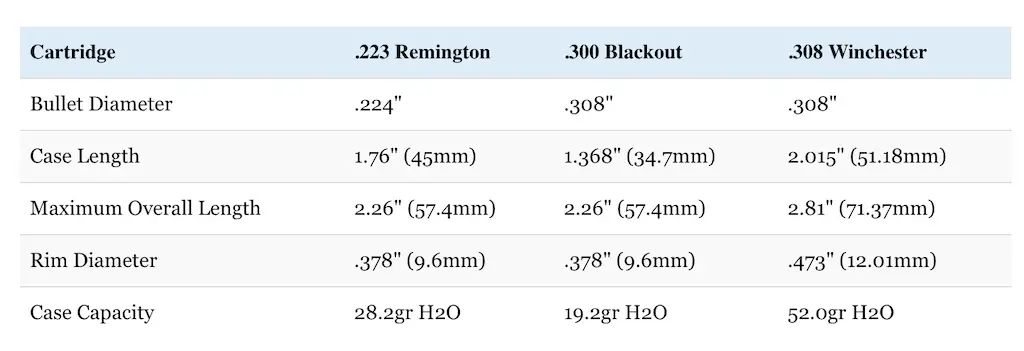
5.56 vs 308 Winchester vs 300 Blackout Ballistics
Just like you’d probably expect from the big differences in their external dimensions, there are some pretty sizable differences in the ballistics of each cartridge.
The table below compares 55gr Winchester Varmint X (.255 BC) and 62gr Barnes TSX (.287 BC) loads in .223 Remington to 110gr Barnes TAC-XP (.289 BC) and 220gr Sellier & Bellot FMJ subsonic (.330 BC) loads in .300 Blackout to 150gr Winchester Deer Season XP (.392 BC) and 168gr Barnes TTSX (.470 BC) loads in .308 Winchester.
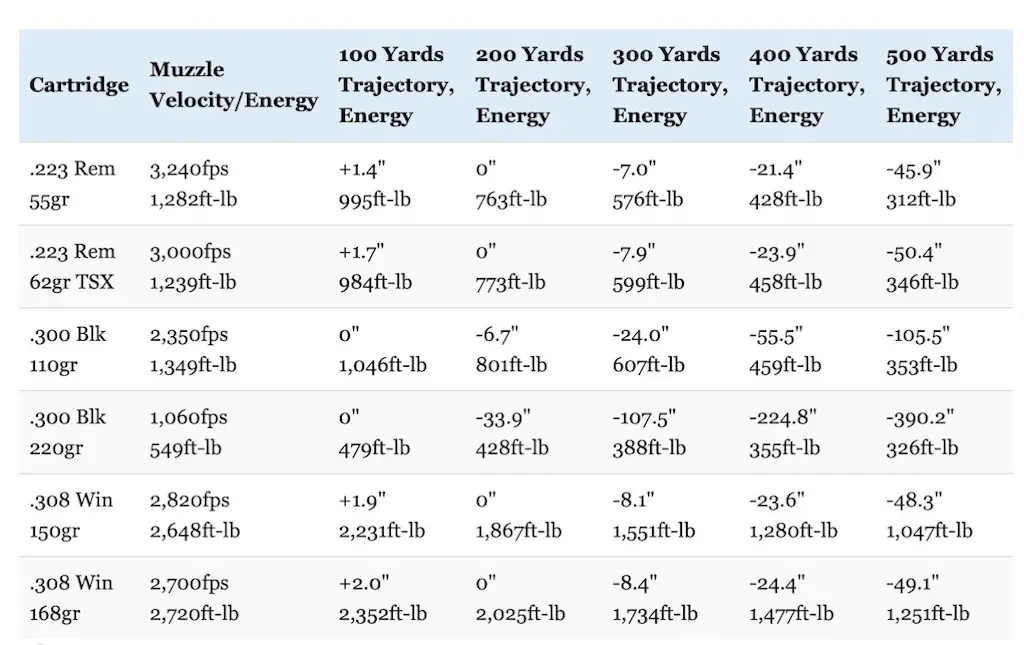
As you can see, there is a really big difference in the trajectory and kinetic energy of each cartridge.
For the most part, the .223 Remington has a significantly flatter trajectory with less bullet drop than the .308 Winchester and the .300 Blackout out to 500 yards. However, the typical supersonic .300 BLK round has a slight edge in kinetic energy over the .223 Remington. At the same time, .308 Winchester load has a gigantic advantage in this department with more than twice the muzzle energy than the typical .223 Remington and .300 Blackout load.
Additionally, the heavier bullets with a higher ballistic coefficient used by the .308 Winchester retain more energy and velocity than the lightweight .223 and .300 Blackout bullets. Indeed, the typical .308 Winchester load still has as much or more energy remaining at 400-500 yards as the .223 Remington and .300 Blackout do at the muzzle.
The table below compares how much a 10 mile per hour crosswind impacts the Barnes loads for each cartridge out to 500 yards.
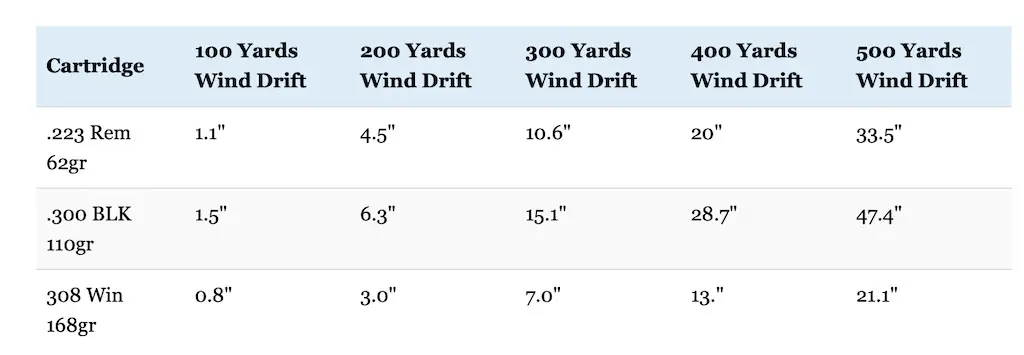
The .308 Winchester has a big edge over the other two cartridges in terms of wind drift. Combined with the superior energy retention of the .308 Winchester at extended range, the .308 Winchester is clearly a much better choice for long range shooting.
That being said, the .308 Winchester has much more recoil than the .223 Remington and the .300 Blackout. For example, when fired from similar rifles (the Ruger Ranch/Ruger American Compact in this case), a typical .308 Win hunting load firing a 165 grain bullet has 3-5 times more recoil than run of the mill .223 Remington and .300 Blackout ammunition.
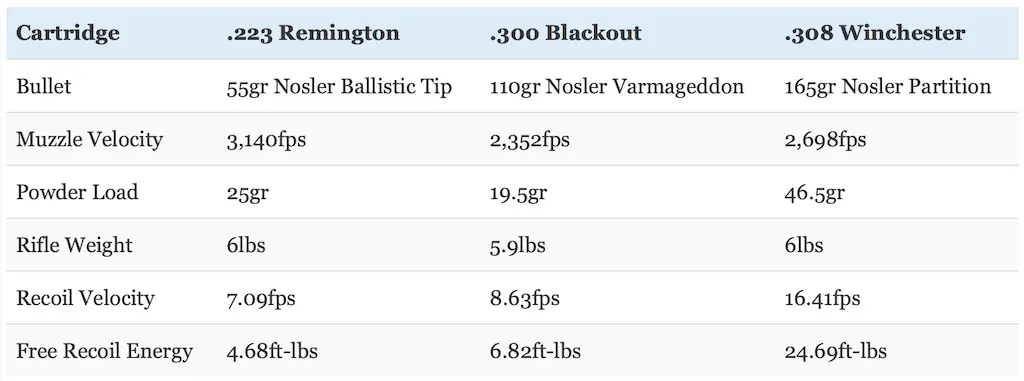
All things considered, most hunters should be able to handle recoil from the .308 Winchester without too much trouble though. The .223 Remington and the .300 BLK just have a very, very mild (almost non-existent) recoil.
Felt recoil will vary from shooter to shooter and rifle to rifle, but free recoil energy is still a useful way to compare the cartridges.
All three cartridges are also very accurate.
Though it’s difficult to choose a winner when it comes to accuracy of the 5.56 vs 300 Blackout vs 308 at short range (150 yards or less), the .308 Winchester has longer effective range and big advantage at ranges past 200 yards because those heavier bullets retain more energy and are less susceptible to wind drift. That’s why it’s the preferred cartridge for military and law enforcement snipers who need the ability to make precise shots at longer range.
5.56 vs 300 Blackout vs 308 Winchester: Ammunition Selection
Since the 5.56x45mm NATO, .300 Blackout, and .308 Winchester are so popular, most of the big ammunition manufacturers produce a variety of ammo for all three cartridges. That being said, the .300 Blackout certainly lags behind the other two cartridges in terms of popularity and availability of ammunition, though it’s not rare or difficult to find by any stretch of the imagination.
Some bullets (like the Hornady GMX, the Nosler E-Tip, and Winchester Extreme Point) are available for all three cartridges. However, lightly constructed bullets designed for varmint hunting (like the Hornady V-Max, Nosler Varmageddon, and Winchester Varmint X) are most common with the .223 Remington. On the other hand, bullets designed for big game hunting (like the Nosler Partition and Swift Scirocco/A-Frame) are most common for the .308 Winchester. Ammunition for the .300 Blackout splits the difference to a certain degree, but bullet choices lean towards big game hunting and self-defense for that cartridge.
There are also a variety of subsonic ammo choices available for the 300 Blackout as well (to include one from Hornady that should work well for hunting).
Of course, this is all in addition to the large quantity of full metal jacket ammunition for all three cartridges that’s currently available.
Prices and availability for vary from region to region, but ammunition for all three cartridges is pretty easy to find. Generally speaking, .223 Remington ammunition is less expensive than .300 Blackout ammo which is less expensive than .308 Winchester ammunition.
BUY SOME GREAT 223 REMINGTON AMMO HERE
BUY SOME EXCELLENT 300 BLACKOUT AMMO HERE
BUY SOME QUALITY 308 WINCHESTER AMMO HERE
If you’d like to learn more about some of the best hunting ammunition choices for the 223 Remington, 300 Blackout, and 308 Winchester, read these articles:
Best 223 Ammo For Hunting Deer, Hogs, And Other Big Game
Best 300 Blackout Ammo For Hunting Deer, Hogs, Predators, And Other Game
Best 308 Ammo For Hunting Deer, Elk, Feral Hogs, & Other Game
If you’re into hand loading, then you’re also in luck because reloading components for all three cartridges are widely available. There are also lots of good quality .224 and .308 caliber bullets to choose from, so you shouldn’t have much trouble working up a custom load that shoots very accurately in your chosen rifle.
Use caution when reloading the .300 Blackout if you plan on hunting with it afterwards. Many .308″ bullets are designed for use with higher velocity cartridges like the .308 Winchester, .30-06 Springfield, 300 PRC, and .300 Ultra Mag. For that reason, you won’t get optimum terminal performance with those bullets at lower impact velocities.
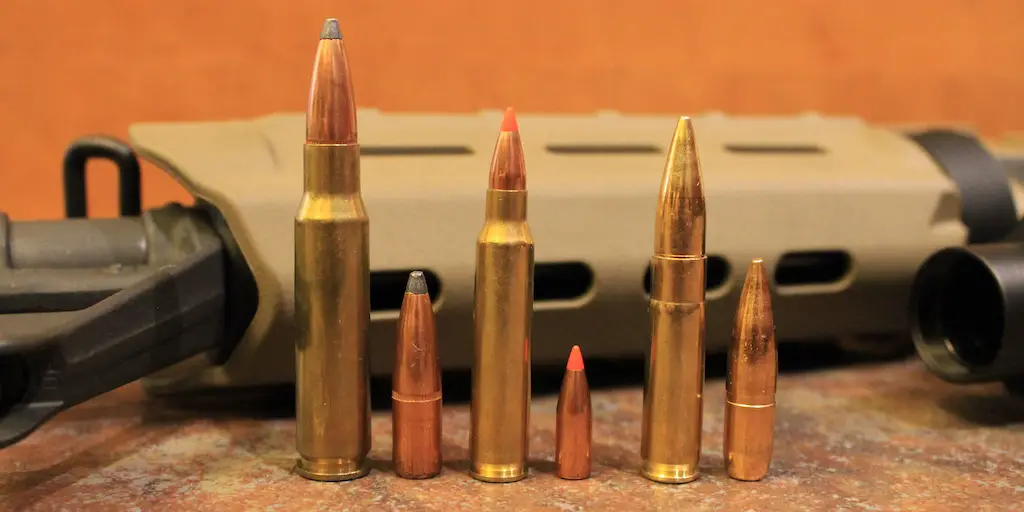
5.56 vs 300 Blackout vs 308 Winchester: Rifle Selection
All three cartridges are very common in semi-automatic rifles.
In particular, AR-15 style rifles like those made by Bushmaster, CMMG, Daniel Defense, DPMS, Noveske, and Wilson Combat, are extremely popular with the .223 Remington and the .300 Blackout. Both cartridges are also available in the Ruger Mini-Fourteen.
Though it’s not quite as popular as the smaller two cartridges in semi-automatic rifles, there are still a number of semi-auto .308 rifles like the Springfield M1A (the civilian version of the M-14) and a few AR-platforms like the AR-10 and the Remington R-25.
Bolt action target and hunting rifles chambered in .223 Remington and .308 Winchester are relatively common like the Remington Model 700, Ruger American, M77 Hawkeye, and Scout, Savage 11/111, and the Weatherby Mark Vanguard. On the other hand, there aren’t many bolt action rifle choices in .300 Blackout other than the Ruger American Ranch and the Remington Model 700 SPS Tactical.
BUY A GREAT 223 REMINGTON RIFLE HERE
BUY AN EXCELLENT 300 BLACKOUT RIFLE HERE
BUY A DEPENDABLE 308 WINCHESTER RIFLE HERE
5.56 vs 300 Blackout vs 308 Winchester: Which Is Right For You?
The .308 Winchester is one of the best big game hunting cartridges around. Roughly comparable to the .30-30 Winchester, the .300 Blackout is also suitable for hunting medium sized game at short to medium range. Both of those cartridges have a definite advantage over the .223 Remington when it comes to hunting medium to large sized game.
Truth be told, the .223 Remington is really just a borderline big game hunting round and can’t come close to the terminal performance of the .308 Winchester on large game. For that reason, the .223 Remington isn’t legal for deer hunting in many states.
That being said, the advent of better quality bullets has made the .223 Remington a much more effective big game hunting than it used to be. Since it is commonly available in semi-automatic rifles and has such a light recoil, follow-up shots are very easy with the .223 Remington. This makes the cartridge a very popular cartridge for hunting situations that require a lot of shooting, like feral hog control. When using a quality bullet like the Hornady GMX, it will really do a number on all but the biggest hogs.
At the same time, the .300 Blackout has virtually all the same advantages as the .223 Remington on big game like light recoil and wide availability in quality semi-automatic rifles. However, the .300 Blackout uses heavier and larger diameter bullets with more kinetic energy. For this reason, it’s arguably a better cartridge for shots on big game inside 150 yards than the .223 Remington (especially when used in a rifle with a good .300 Blackout scope).
The flat trajectory and lightly constructed bullets most common with the .223 Remington make it an extremely effective round for taking shots at small, thin skinned animals like prairie dogs, bobcats, and coyotes.
On the other hand, since it shoots heavier, larger diameter, and generally much better constructed bullets, the .308 Winchester has a clear advantage when hunting larger species like deer, caribou, elk, and most species of African plains game. It’s a little on the light side for moose and grizzly/brown bear, but it will work in a pinch with proper shot placement.
Do you want a cartridge ideal for elk, bear, or deer hunting? Get a .308 Winchester since it’s by far the most powerful of the three. It’s an outstanding big game hunting cartridge and there are lots of great ammunition choices specifically designed for that sort of hunting.
Are you looking for a cartridge to hunt predators and small game animals with? The .223 Remington is the better choice here because it has a flatter trajectory, ammunition is cheaper, and there are many types of .223 ammo specifically designed for predator and varmint hunting.
Are you very sensitive to recoil? Depending on what exactly you’re hunting, you should go with either the .223 Remington or the .300 Blackout. Though the .223 Remington has slightly less recoil, both cartridges are very tame and are suitable for small framed or otherwise recoil shy shooter and hunters. For hunting big game, go with the .300 Blackout and limit your shots to inside 150 yards. For general target shooting or varmint hunting, go with the .223 Remington.
Do you want the ideal cartridge to use with a suppressor or in rifle with a short barrel? The .300 Blackout has the advantage here. The .300 Blackout has a good reputation for cycling the bolt reliably when using subsonic ammo and when used in short barreled rifles. Additionally, it doesn’t suffer nearly as big of a drop off in performance as the .308 Winchester or .223 Remington with a shorter barrel length either.
Do you want a cartridge suitable for self or home defense? All three cartridges will certainly work in this regard, but the .300 Blackout probably has the edge here as well. Like the .223 Remington, it also has a very mild recoil that facilitates follow-up shots, but it shoots a larger and heavier bullet with more energy. There are also lots of good choices of purpose built self-defense ammo with very good terminal ballistics for the .300 Blackout round (like the Barnes TAC-TX and Lehigh Defense Close Quarters Bullet).
Are you looking for a cartridge with lots of inexpensive ammo for general plinking or target shooting? Though .308 Winchester ammo is pretty widely available as well, but the .223 Remington is arguably the easiest to find and least expensive centerfire cartridge in the United States.
Are you looking for an ideal cartridge to use in an AR platform? All three will work here, but the .223 Remington and to a lesser degree, the .300 Blackout are most common in good quality AR-15 style rifles.
As I’ve stated before: the .223 Remington/5.56x45mm NATO, .300 Blackout, and .308 Winchester are all excellent rifle cartridges. However, since the difference between them (5.56 vs 300 Blackout vs 308) is pretty big in certain respects, each cartridge is better suited to specific situations than the other. I hope this article has done a good job of explaining the strengths of each cartridge and was useful for helping you decide which one you should use.
For a more detailed discussion on the .308 Winchester and how it compares to the 6.5 Creedmoor cartridge as well as how the .223 Remington compares to some other popular high velocity cartridges, read the articles below:
22-250 vs 223 vs 204 Ruger vs 220 Swift: Clash Of The Speed Demons
Enjoy this article about the 223/5.56 vs 300 Blackout vs 308 Winchester debate? Please share it with your friends on Facebook and Twitter.
Nosler provided the load data used to compare trajectory, case capacity, and recoil for the cartridges (here, here, and here). The Lyman 50th Edition (p139-143, 231-233, & 241-245), and Hornady 10th Edition (p160-178, 435-433, & 474-488) reloading manuals were also used as references for the history of the cartridges. I used the Hornady Ballistic calculator and Handloads.com to compare wind drift and recoil for the cartridges.
Make sure you subscribe to The Big Game Hunting Podcast and follow The Big Game Hunting Blog on Facebook, Instagram, Twitter, and YouTube.
NEXT: BEST 6.5 CREEDMOOR AMMO FOR HUNTING ELK, DEER, & OTHER BIG GAME
NEXT: 101 BEST GIFTS FOR HUNTERS
John McAdams is a proficient blogger, experienced shooter, and long time hunter who has pursued big game in 8 different countries on 3 separate continents. John graduated from the United States Military Academy at West Point and is a veteran of combat tours with the US Army in Iraq & Afghanistan. In addition to founding and writing for The Big Game Hunting Blog, John has written for outdoor publications like Bear Hunting Magazine, The Texas State Rifle Association newsletter, Texas Wildlife Magazine, & Wide Open Spaces. Learn more about John here, read some of John’s most popular articles, and be sure to subscribe to his show: the Big Game Hunting Podcast.



Good stuff John ! Down here in S Texas we have a lot of hogs
I hunt them with dogs so generally I use a knife but we often encounter some real bruisers. For them I use a 44 mag with hollow points. Dog safety is a must. Farmers down here have taken to using helicopters. So I am looking for a semi-auto to shoot dog or helicopter driven hogs breaking out of the grain fields.
Glad you found the article useful Roger. Have you made a decision on which one you want to go with yet? I personally lean strongly towards the 223/5.56 for hogs.
John
First off great article. Simple to understand.
I am looking at an AR pistol to use for home self defense and also keeping the coyotes away. I live on 10 acres but have neighbors on each side and across the street only about 50-200 yards away so any coyote or wild dog shot is going to have to be fairly close quarters. The inside of my house never has any more than 30 feet of open space and the exit from the bedroom to the living room is kind of tight which is why I am considering an AR pistol versus a rifle. Any advice?
The .300 Blackout is a pretty good choice if you’re looking for something that performs really well out of a shorter barrel. It’s excellent out to 200 yards or so and gives you performance comparable (more or less) to the 30-30, but in an AR platform. The 223/5.56 really depends on velocity for best performance, so you lose a lot by shooting those rounds through a shorter barrel.
Hope this helps!
John
Everyone forgets or maybe they don’t know. The .300 blackout was created as military gun for close quarters. The military asked for something that could be used on the AR platform and could be suppressed that gave more than a 9 mm. It had be in size close to an h&k mp5 in size. The .556 will not operate with a suppressor and sub sonic ammo. The .300 blackout was not created for long range